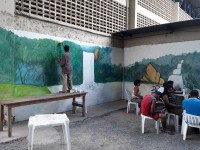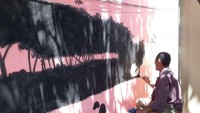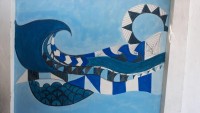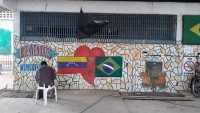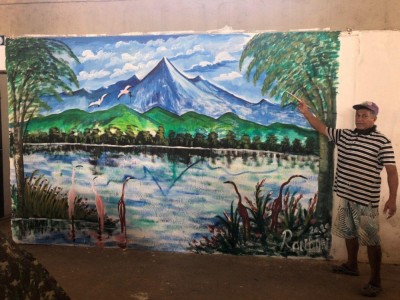Painting, music, handicrafts and other artistic expressions are encouraged among the Venezuelan refugees in the shelters.
Venezuelan refugees have found support for not only physical needs – such as lodging and food – but also for emotional and intellectual ones, thanks to the art education project “The Common Good” and other artistic activities carried out in shelters in the State of Roraima, which are maintained by the United Nations High Commissioner for Refugees (UNHCR) and managed by the Fraternity – International Humanitarian Federation (FIHF).
On April 15th, as we celebrate the World Day of Art, we will explore this project which uses all the human artistic potential to transform disposable objects and white walls into art and life.
Art Education Project “The Common Good”
In the indigenous shelter Pintolândia, the children of the E’ñepa tribe participated in a beginners workshop for music with percussion instruments.
“Our intention was to provide a moment of dynamic welcome, where working with sound and rhythm could help children. It is one of the possible educational intervention strategies to deal with the gap that traumatic situations such as forced immigration can generate,” explains one of the facilitators of the workshop, the missionary of the Fraternity – International Humanitarian Federation (FIHF), Sister Maria, also a coordinator of the project.
Before the classes, songs are intoned in the languages of the indigenous tribes that live in the shelter – Warao and E’ñepa – as well as in Portuguese and Spanish.
The artistic workshops, besides serving as recreation for those involved, reinforce the internalization of values that support resilience and bring hope in face of possible traumas coming from immigrating from a country in crisis.
“Art assists in the expression of anguish-generating emotions, as well as promoting its redefinition,” explains Sister Maria.
Free and thematic drawings, watercolor and poster paint, the design of mandalas, murals, carpentry with artistic finishes and theater are some of the other activities developed daily in the shelters.
Building with Art
But it is not only the project, The Common Good, that promotes art. In the Tancredo Neves Shelter, the missionaries began a renovation in the room to be used for the handicraft, sewing, and art workshops.
The elderly with experience in painting and young people thirsty to learn and express, unite in the creation of what will be a space destined for creativity.
Being 65 years old and a painter since he was 48, Antônio Rondon was a teacher in plastic arts, art education, painting and technical design. His greatest joy, he says, is in teaching children so that they can learn to paint from a young age. Now, even though he is far from his country, he continues his mission.
- Antônio Rondon plastic arts teacher in Venezuela
- Antônio Rondon plastic arts teacher in Venezuela
During the activities, those in the shelter fill the environment with other expressions. A youth with special needs, with mutilated arms and legs, revealed himself to be a singer.
An elderly person approached a missionary who was recording the activities with a camera and asked for a photo. Immediately, all those present in the place asked for photographs, and then saw their images portrayed. When asked about the importance of photography to them, one of the young people responded: “it’s because people have value!”
- Mr. Jesus Salvador, who asked to be photographed
Plastic bottles are painted and transformed into flower vases. White walls are filled with suns, hills, trees and animals. Some paint houses, others, realistic waterfalls, and there are those who draw the sea in geometric shapes. With their subjective points of view, personal inspiration and experiences, together they now form their own homes, full of portraits of a world where there is nothing more important than life.




